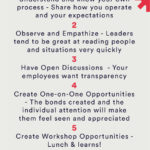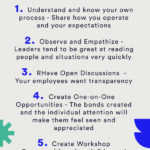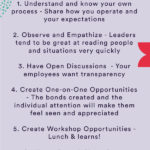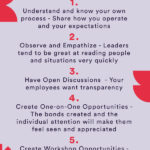You work hard to attract and retain talented employees. How do you cultivate their skills to grow with your company? This piece will discuss best practices in creating a culture of leadership development and how that contributes to overall performance and succession planning.
Understand and know your own process
You set the tone for everyday operations. Set these processes in stone and share with your team open and honestly how you operate, and what you expect from them.
Observe and Empathize
Leaders also tend to be great at reading people and situations very quickly, so use that to your advantage in identifying the type of people working for you, their process and possible barriers. Who are they at their core, what is their personality in life? How do your employees engage — Are they bullish, are they on the sidelines? Are they robotic, emotional, chaotic? Watch, observe and take notes. Who are the people around them adding to the dynamic? If there are multiple people and teams, take a moment to check if the balance is there, if not, what will bring out the best in people?
Have Open Discussions
Your employees want transparency. The people that work for you like understanding where they are in relationship to the work and the business. When things are under cloak and dagger, they assume. And assumptions are rarely positive or correct. Sharing as much as possible with the team allows a transparency culture throughout the business. Give them feedback not once a year, but in the moment. If that’s not possible, then after every project or on a routine basis. This will allow for specific instances to be discussed and allow a shift in their approach the next go-round.
Create One-on-One Opportunities
People thrive on connection and attention. Create a coffee or lunch date for your employees to talk about their challenges and opportunities. This is a time to listen, not talk. If you can’t personally take time to have one-on-ones, then empower someone in a leadership position to do this. The bonds created and the individual attention will make them feel seen and appreciated. And that appreciation will pay off in spades in dedication and passion for their job.
Create Workshop Opportunities
Lunch & learns, routine group check-ins and simple team discussions aid in giving them tools to use in work and their own lives. These should be fun, engaging and feel like a treat, not a chore. Simple investments on your part are rewarded with allegiance and excitement from your employees.
Outline a Growth Plan
The number 1 stress of an employee is not what you’d expect. It’s not money or time off. It’s an unclear vision for the future and themselves. Finding out what do they want ultimately want to do is pivotal so that they can feel invested in creating something of value with the time they spend at the company. Now, can you help get them there? Do they need more training? More opportunities to shine? Do they need less work, better lunch options? Listen to their grievances and their victories and create a way for them to move up and on. You literally want them to leave your company within a number of years because they will give everything they have to obtain their goals. And the next person you get will infuse your business with new energy, bright ideas and a passion to succeed.























